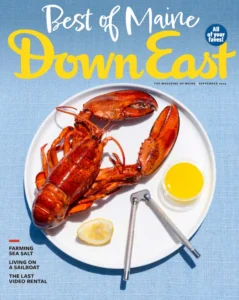SPONSORED CONTENT
Lobster 101
How to Cook a Live Lobster
Check out lobsterfrommaine.com for recipes and meal ideas.
Boiling is the best approach if you want to serve a whole lobster or use a recipe that calls for cooked, picked lobster meat. Boiling is a little quicker and easier than steaming, and the meat comes out of the shell more readily.
1 Choose a pot large enough to hold all the lobsters comfortably; don’t crowd them. A 4- to 5-gallon pot can handle 6 to 8 pounds of lobster.
2 Fill the pot with water, allowing 3 quarts of water for every 1½ to 2 pounds of lobster.
3 Add ¼ cup sea salt for each gallon of water.
4 Bring the water to a rolling boil.
5 Add the live lobsters one at a time and start timing immediately. Cover.
6 Stir the lobsters halfway through cooking.
7 Let the lobsters rest for about 5 minutes after cooking to allow the meat to absorb some of the moisture in the shell.
How Long to Cook That Lobster?
Tips from chef Jasper White’s authoritative Lobster at Home.
Lobster Weight . . . Boiling Time (in minutes)
1 lb . . . 8
1¼ . . . 9–10
1½ . . . 11–12
1¾ . . . 12–13
2 . . . 15
2½ . . . 20
3 . . . 25
5 . . . 35–40
How Do You Know If
It’s Done?
The bright-red color isn’t always the best indication, White writes: Once you’ve cooked the lobster for the recommended time, crack one open where the tail meets the body. If it’s done, the meat will be white. If it’s translucent, it needs more time to cook.
Simple Lobster Shell Stock
You can enjoy the rich taste of lobster long after you’ve savored its sweet meat. Lobster shells make a beautiful stock for chowder, bisque, risotto, broth, consommé, bouillabaisse, and paella, as well as for pasta and rice dishes. It takes just three simple steps.
[dropcap letter=”1″] Remove the head and put the shells from the body, legs, and tail into a roasting pan with diced onions, celery, and some butter. Roast until aromatic in an oven heated to 400 degrees. Stir periodically so the shells don’t burn.
[dropcap letter=”2″] Crush the shells in a saucepot with a potato masher or mallet and add just enough water to cover the shells, along with white wine if you like.
[dropcap letter=”3″] Add 1 tablespoon of tomato paste and ½ teaspoon of paprika per cup of water and bring to a boil, then simmer slowly for about an hour. Strain with a fine mesh strainer to eat immediately or freeze for later.
> To learn more, go to lobsterfrommaine.com.
How to Pick Out a Lobster
Look for the lively ones: The best picks are lobsters that move around, hold their claws upward, and keep their tails straight.
Pick a color, any color: Maine lobsters are usually greenish brown or black, but can also be blue, yellow, red, or white. The color of the shell does not affect flavor or texture. All lobsters turn red when they are cooked.
It’s All About the Shell
Lobsters shed their shells once a year, to grow larger. These new-shell lobsters — available live in summer and fall — have sweet, tender meat that can be easily extracted from their crisp orange shells with a diner’s bare hands. No fancy tools necessary; all you need is a stack of napkins!
Sustainable
Seafood
For more than 150 years, Maine’s lobstermen have worked to keep the fishery strong. All lobsters are caught by hand, one trap at a time. Maine law limits the number of lobstering licenses and how many traps each fisherman can set, forbids the fishing of both juvenile and oversize lobsters, and protects known breeding females, all to ensure the propagation of the species.
Lobster: An Economic Engine for Maine
+5,000 lobstermen (that’s men and women)
$434 million in annual lobster landings in 2017
$1 billion generated for the economy by the lobster supply chain — the lobster dealers, distributors, and processors who get the lobster from the dock to the consumer
+4,000 jobs created by dealers, distributors, and processors



